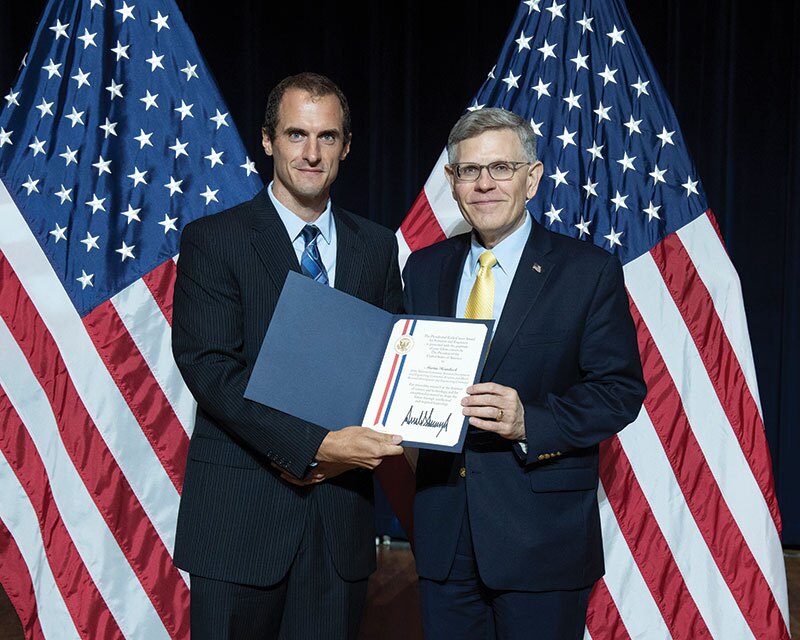UNA Alumnus Receives Presidential Award for Scientific Work, Outreach

Heimbeck (left) receives the Presidential Early Career Award for Scientists and Engineers (PECASE) from Kelvin Droegemeier, Director of the United States Office of Science and Technology Policy, during a ceremony in July 2019.
The White House this summer announced the most recent recipients of the Presidential Early Career Award for Scientists and Engineers, and among them is an alumnus of the University of North Alabama.
Martin Heimbeck, a 2006 graduate in physics, is one of only two recipients from Alabama in this latest round.
Heimbeck said he first learned he was nominated for the award about three years ago.
“I found out in June that I was one of the recipients, with the invitation to basically go up to Washington, D.C., two weeks later to receive the award,” he said. “For me, it was great to be recognized, and obviously, my organization — they were proud of having that accomplishment within their organization.”
The PECASE award was established in 1996. It is “the highest honor” the United States government gives to scientists and engineers in the beginning stages of their independent research careers. It is given to those who show “exceptional promise” for leadership in science and technology, according to the White House.
Heimbeck works for the Army CCDC Aviation and Missile Center at Redstone Arsenal in Huntsville. He joined several other science and technology professionals from across the nation at DAR Constitution Hall to receive the award.
According to a press release, his research on terahertz radiation — the region between microwaves and infrared waves — contributed to his nomination by the Department of Defense.
“It has properties that can see through certain materials, like opaque plastics, non-destructively and provide information about them, to see if there is any damage to the interior structure,” he explained. “This technology can be applied to composite materials, which are of high strength but of low weight, used on helicopters, so that we can see any defects in the structure before they can lead to failure. It’s analogous to X-rays we use to look at our bones.”
This kind of scientific exploration, as well as leading projects and collaborating with others, are all factors in the selection process, according to Heimbeck.
Volunteer work and outreach are also essential factors.
Originally from Germany, Heimbeck said he knew he wanted to be a physicist since high school. He earned a degree in physics as an undergraduate student at UNA before furthering his education at the University of Alabama in Huntsville, where he later taught physics.
While at UNA, Heimbeck said he enjoyed the experience of a small campus and playing Frisbee golf with friends.
“My girlfriend — who is now my wife, Amber — was also a physics student there,” he said. “And I had a great professor, Dr. Brian Thompson, who was a mentor to me.”
Thompson, chairman of UNA’s Department of Physics and Earth Science, said he still remembers Heimbeck for his accomplishments and contributions to the department.
“I most enjoyed working with Martin over the two semesters of his directed research project in experimental optics,” he recalled in the release. “He showed attention to detail through repetitious measurements, dedication to work through failures, and the intuition to try new ideas.”
Thompson also touted Heimbeck for his example as president of the Society of Physics Students, as well as his efforts in organizing and winning a grant for an outreach project with fourth graders.
Heimbeck and other students would visit fourth-grade classes and present small science experiments.
“We continued some of that at the local Physics Club at UAH, but it all started at UNA with one of my professors there,” Heimbeck said.
The goal, he explained, was to make science more interesting for students as they start deciding whether they like or dislike the subject.
“Hopefully, we kind of sparked the interest for them to keep going and keep science and these subjects in their mind as they’re going through school,” he added.
That project would later contribute to Heimbeck’s PECASE win.
Today, Heimbeck said he enjoys working to develop new methods and technologies for the Army, even when the research doesn’t go as expected.
“I enjoy what I’m doing right now, and I see myself continuing my career in the technical field and collaborating with universities, and leading projects that follow the mission of the Army’s organization here and hopefully be beneficial to the men and women in uniform in the future,” he said.
“It’s important to fund this kind of work and take the risks, because we’re better to have failed and go in a different direction than to not try and never know.”



